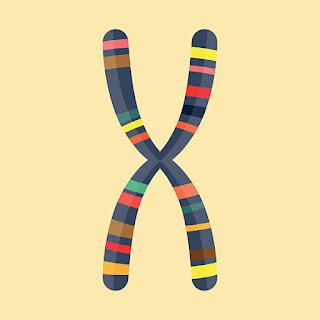Types of chromosomes on the basis of centromere
The position and number of centromere may be variable
According to the number of centromere, chromosomes are of following Types
Centromere may be variable in different chromosomes.
Acentric:
These are the chromosomes Witnout any centomere
Monocentric: These chromosomes have one centromeree
Dicentric:
These chromosomes have tw0 centromeres,
Polycentric:
These chromosomes have more than two centromere.
Types of chromosomes according to the position of centromere
(
Telocentric)
These are rod-shaped chromosomes these have chromosomes at their proximal end.
ii)Acrocentric:
These are also rod-shaped chromosomes but the
centromere is
between two chromatids in such a manner that one arm is short and another
is long.
iii)Sub-metacentric:
These are J or L-shaped chromosomes. In these.
centromere is present in the centre in Such a manner that two unequal arms are formed.
iv) Metacentric:
These are V shaped chromosomes in these chromosomes centromere is present almost in the center and two arms are formed.
Kinds of Chromosomes
According to the function the chromosomes are of two kinds chromosomes:
(1) Autosomes:
These chromosomes contain the genes of various characters except
reproductive organs. They have no concern with the determination of sex organs.
Sex chromosomes:
These chromosomes contain the genes of reproductive
organs. They determine the sex. These chromosomes are of two types, X-chromosome and Y-chromosome. X-chromosomes determine female and Y-chromosomes
determine male.
Some special types of chromosomes are
as follows:
() Lampbrush chromosomes
(i) Salivary gland chromosomes or polytene chromosomes
(ii) B-Chromosomes
(i) Lampbrush Chromosomes:
This kind of chromosomes are found in spermatocyte nuclei of Drosophila. These
are also found in oocyte nuclei of both vertebrate and invertebrate animals.
These chromosomes were discovered by
Ruchert in 1892.
These chro-
mosomes
are enormously
enlarged in
size even
larger than
salivary
gland chro-
mosomes.
These
lampbrush-
shaped.
They contain a main axis. The chromosomal fiber of DNA molecule produces
many lateral loops and these loops produce RNA molecules of different kinds.
During the process of meiosis the number of loops increase gradually and in
diplotene stage these loops reach in their maximum number. Later on as the meiosis proceeds, the number of loops decreases and finally these loops disappear.
(
ii) Salivary gland chromosomes or Polytene chromosomes:
These chromosomes are found in the salivary gland cells of Diptern species,
like Drosophila. These chromosomes were discovered by E.G. Bulbiani in 1881.
These chromosomes are very large in size and may reach up to 200 times or
more than the size of a normal chromosome. These are visible in meiosis or in
the nuclei of mitotic cells.
These chromosomes show alternate dark and light bands
along their length. The dark bands are present along the
whole diameter of chromosome. These bands are disc
shaped and contain euchromatin.
Light bands are the inter-bands and consist of heterochromatin.
(iii) B-Chromosome:
These chromosomes are different from autosome and sex-chromosomes. These are
without any genetic function. These are also called Accessory or Supernumerary
chromosomes. These are found in many plants, such as Maize or in insects and
small mammals.
These chromosomes have normal structure but smaller than autosomes. In some
organisms these chromosomes consist of Heterochromatin. Like Maize, many insects
etc., and in some organisms they consist of Euchromatin, e.g. Rye.
Karyotype or arrangement of chromosomes:
In each cell the chromosomes appear in different manner. Their size, shape, length
of two chromatids and position of centromere i.e. all characters are different from other
cells. When the chromosomes of a species show a specific arrangement according to
their shape, size and arrangement, it is called its karyotype. It is the proper arrangement
of chromosomes. When it is shown by figure, then it is
called ldiogram.
Chromosomes as carriers of genes:
Genes are small bodies found in the chromosomes. Chromosomes are easily
visible under microscope, but genes are diticult to observe due to their small size. Genes
contain hereditary characters, which are transferred into new generation by the help of
chromosomes.
The chromosomes are considered as carriers of genes
(i) When homologous chromosomes are separated at the time of meiosis, then
segregation of genes also takes place.
In the genotype of each individual a pair of genés is present, one member of each
pair comes from one parent and other member from other parent. It also occurs in
zygote, where chromosomes are present in pairs, and both parents contribute in
these chromosome pairs.
(ii
) In each pair two chromosomes contain similar genes, so they are called homologous
Chromosomes, so for each character two alleles are found on a particular locuS. As
a result of meiosis each gamete, either sperm or egg contains only one member of
each allelic pair i.e. each sperm or egg receives only one gene of each pair
Genes are considered as basis of all breeding experiments and purity or
gametes. When genes are present in the chromosomes, during meiosis reduction division
Takes place and genes are segregated (separated) from each other at the time of
OOgenesis (ova formation) and spermatogenesis (sperm formation






Comments
Post a Comment